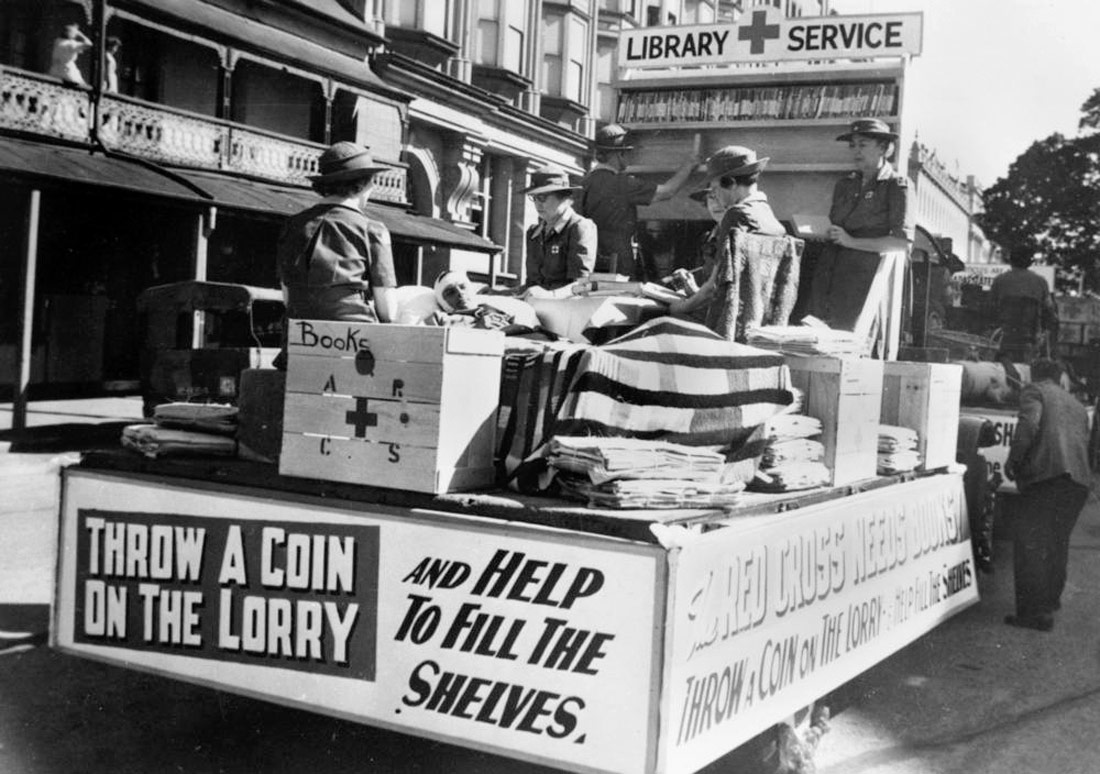
Book Depot float, Red Cross Procession. Brisbane, 1944 | State Library of Queensland | Public Domain
In a society in which we’ve turned libraries into polyvalent, multimedia facilities, an experimental library project in Seoul is still allowing books to take centre stage. To do so, these centres have turned reading into a living experience. In a society where all the information we need is just a click away, the future of libraries may be thematic, offering spaces where everyday activities such as cooking, travelling or listening to music are blended with reading to create a unique collective sensorial experience.
Under the corporate moniker of Hyundai Card Libraries, over the last five years, four small libraries have opened up in Seoul, the concept and very existence of which were completely unexpected. In today’s world, where libraries tend to be polyvalent, multimedia facilities, these four are small specialised laboratories. In a period in which libraries are full of people looking for a quiet place to focus on their screens, in these four libraries, the books are consulted in relation to objects which give them meaning – the texts lead to physical action, rather than to technology. In the Design, Cooking, Music and Travel libraries, books still take centre stage.
The Design Library resembles a small contemporary art museum, with a garden in the centre onto which the building’s three stories look out. Its three areas are designed according to classic librarianship criteria: the first contains books on contemporary art, museum catalogues, journals and periodical publications and texts on industrial design; these are also found in the third area, together with literature on architecture, interior, public and organic design and photography; while the second houses material on book design, marketing, visual communication, user design and miscellanea. As an example of the latter, in a tiny corner on the second floor, next to a cubicle with views over the rooftops of the neighbouring hanok houses, one can find a score of some books on smallness – bathrooms, miniatures, minimalism, micro-apartments.
For a book to be selected as part of the Design Library’s collection, it must be inspiring, useful, explicative, influential, a classic (established or in the making) and beautiful. The other libraries have also published the guidelines followed by their respective librarians when selecting works for their collections. As such, what makes this project standout is not that it offers new concepts related to the literary dimensions of libraries, but that the curation and physical arrangement create an atmosphere that is miles apart from anything you would find in the library of a design faculty. The architecture and all the details have come together to create a different experience; one that is sensorial, unique and very pleasant. Next to the tables and chairs provided for reading, there is a coffee machine and fridge with bottled water. On any flat surface were a book can be rested, there are wooden boxes with Faber-Castell pencils and blank paper. Everything has been designed and chosen to make readers feel privileged, to feel they will be able to enjoy turning their reading experience into notes, drawings and future projects.
Each of the four libraries offers its own distinct bookmarks, which reflect the uniqueness of each project. They also simbolise the interrelatedness of these four different embodiments, each of which is passionate about both the feel and design of paper. The leaflet that explains the Hyundai Card Libraries is made with exquisite taste, as paper books are at the heart of experience: publications on art, crafts and design in the Design Library; recipe books and books on raw ingredients and cookery in the Cooking Library; travel literature, maps, guide books and the entire National Geographic collection in the Travel Library; biographies of singers, texts on musicology, scores and books for music lovers in the Music Library. Then there are all the tools that help to turn reading into a living experience and something to be remembered. The pencils in the Design Library. The records and record players in the Music Library (on sale in the shop next door – Vinyl & Plastic). The interactive maps in the Travel Library. The trays, pans, hobs and ovens in the Cooking Library. The reader becomes an active creator. In this stimulating context, they don’t gain their knowledge from Youtube or Wikipedia, but rather from a book, which they will probably have found together with their partner or friends. Thanks to the maps, record players, coffee and restaurant tables, reading becomes a collective, group experience that stimulates all five senses. As Damon Krukowski writes in The New Analog. Listening and Reconnecting in a Digital World (The New Press): “I see the digital disruption of our cultural life as an opportunity to rethink the analog/digital divide and re-examine what we’ve discarded – not in order to clean it up and put it back to use exactly how it was, but to understand what was thrown away that we still need”.
All four libraries house structures that are reminiscent of a portable home. In the Design Library, it’s the shape of a wooden cabin; in the Travel Library, an irregular ceiling in a honeycomb pattern like that of an attic room in a bed and breakfast; in the Music Library, there are modules that recreate the intimacy of a bedroom where teenagers put together their playlists (and a concert or disco hall); and in the Cooking Library, a type of outdoor greenhouse that doubles up as a dining room, as well as another indoor room where all types of ingredients are displayed and classified. The aim is to offer safe, peaceful spaces where visitors can develop skills and knowledge that they normally wouldn’t gain either in college or the workplace. Practical spaces that are related to domestic life, leisure, reading for pleasure, the warmth of a shared semi-public home; not with professional life or the direct transformation of work into money.
The access key to these four libraries is a Hyundai credit card. Their very existence, in fact, is a result of the crisis in which the banking section of this multinational was submerged. The CEO of Hyundai Card and Hyundai Capital, Ted Chung, decided to invest several million euros in an unprecedented initiative – the creation of four knowledge centres that would be attractive meeting places for young people. Creative, social spaces that offer an alternative to cafés and karaoke bars; places that are also capable of drawing people in. Listening to music, designing a room or a house, planning a trip or cooking with friends… why couldn’t these things take place in a library? The exclusive access and media impact made this disruptive idea a profitable one.
These four unexpected cultural centres are a continuation of the mission of Chung Ju-yung, the creator of the Hyundai empire and a model for global entrepreneurs with his Molotov cocktail blend of self-made success, the scope of Ford, psychopathic speed and efficiency and patriotic commitment. In Made in Korea. Chung Ju-yung and the Rise of Hyundai, Richard M. Steers mentions that in 1970 he founded the University of Ulsan and in the late 90s he funded the construction of a large new building for the Ewha Womans University. It may be that in the 21st century, the strategy of strengthening a society’s education needs to be channelled not through universities but through thematic libraries for people of all ages.
Although the existence of private libraries is not exclusive to our time (the best university libraries in the United States are private, and even the New York Public Library belongs to a private foundation), it is true that in recent years, some companies have started offering their customers exclusive benefits through cultural foundations that are open to the public. This is the case in Spain, with the cultural centres of La Caixa, which offer free entry for the bank’s customers and paid entry for other visitors. Beyond the long-standing culture of public-private partnerships, which in Spain has led to the collapse of the local networks of cultural and social centres funded by the banks, experiments of this kind initiated by multinationals should be seen as seed beds for ideas that could be incorporated into public libraries in the future. Travelling, cooking, listening to music and drawing are all profoundly human activities in which reading is a means to an end. This could prove to be a fertile logic on which to design the libraries of the future. If all the information we need is already available on the internet, what can libraries offer? Experiences that are profoundly digital, but not in the electronic sense of the word. Experiences in which the digits of our hands are put to use in everything from reading to different creative arts. It’s not for nothing that most architectural studios, although they use extremely expensive 3D simulation software, continue working with cardboard models.

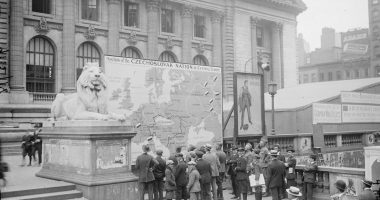
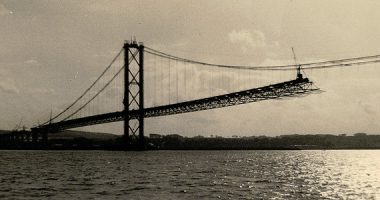
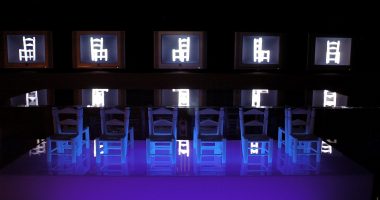
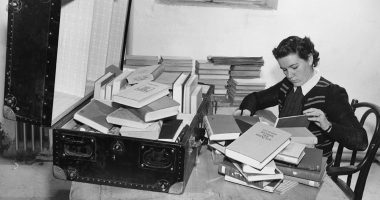
Gicelt Solaro | 16 January 2019
EXCELENTE iniciativa, una visión nueva y refrescante para la lectura y sus milenarias instituciones, las bibliotecas.
EXCELENTE nota.
GRACIAS!
Leave a comment